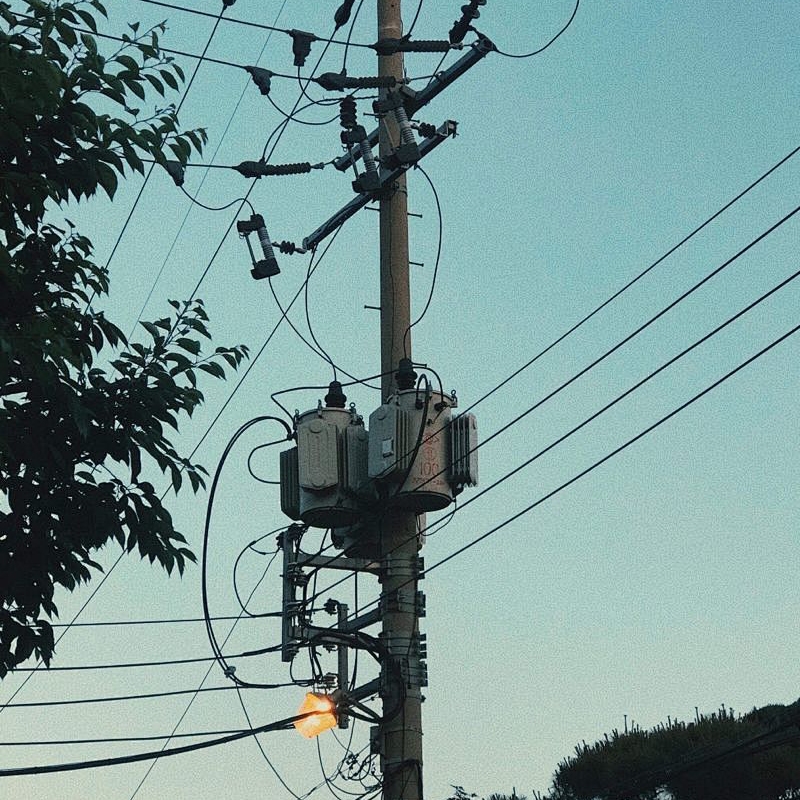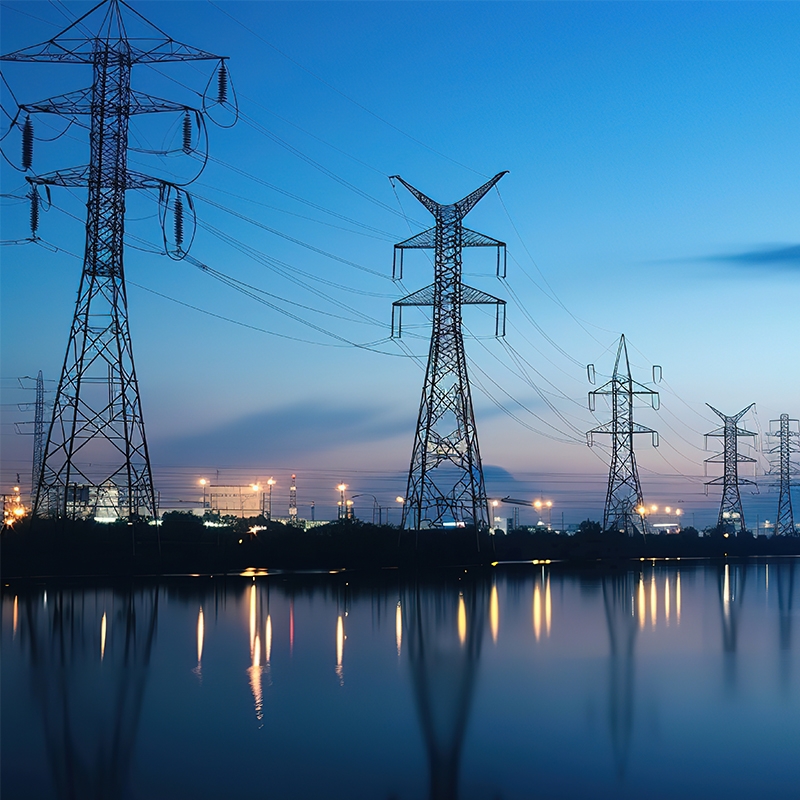Three phase oil immersed transformer knowledge
The core part of a three-phase oil-immersed transformer is composed of a closed iron core and a winding on an iron core column. In addition, there are fuel tanks, oil storage tanks, bushings, breathing apparatus, explosion-proof tubes, radiators, tap switches, gas relays, thermometers, oil purifiers, etc.
(1) Iron core
The core is the magnetic part of the transformer. In order to reduce the hysteresis and eddy current losses in the iron core, the iron core is composed of 0.35mm ~ 0.5mm thick silicon steel sheets, the surface of the silicon steel sheet is coated with insulating paint or the surface oxide film is used to insulate each other. The vertical part of the core of the three-phase transformer is called the core column, on which the low-voltage winding and high-voltage winding of the transformer are covered; The horizontal part, called the yoke, is used to form a closed magnetic circuit.
(2) Winding
The winding is also called the coil, which is the circuit part of the transformer and is divided into two kinds of primary and secondary winding. The winding connected with the power supply is called the primary winding, and the winding connected with the load is called the secondary winding. The primary and secondary windings are made of copper or aluminum wire wrapped with high strength insulation. Each phase primary and secondary winding of the three-phase transformer is made of a cylindrical sleeve on the same core column, the low-voltage winding with fewer turns is set inside close to the iron core, and the high-voltage winding with more turns is set outside the low-voltage winding. This is because the low-voltage winding insulates the core more easily. Between the low voltage winding and the iron core and between the high voltage winding and the low voltage winding are isolated by a sleeve made of insulating material to insulate them reliably. In order to facilitate heat dissipation, there is a certain gap between the high and low windings as the oil channel, so that the transformer oil can flow.
(3) Fuel tank
The oil tank is the shell of the transformer, in which the iron core and winding are installed and filled with transformer oil. For transformers with relatively large capacity, heat sinks or heat dissipation pipes are installed outside the tank.
Transformer oil is a kind of mineral oil with good insulation performance, which has two functions: first, the insulation performance of transformer oil is better than that of air, and the winding immersed in oil can improve the insulation performance everywhere, and avoid contact with air to prevent the winding from being damp; The second is the heat dissipation effect, using the convection of oil, the heat generated by the iron core and winding is distributed to the outside through the box wall and the heat dissipation pipe. Transformer oil with its freezing point is divided into 10, 25, 45 three specifications, their freezing point are -10℃, -25℃, -45℃, generally according to the local climate conditions to be selected.
(4) Oil storage tank
The oil storage tank, commonly known as the oil pillow, is a cylinder row container, placed above the tank, connected with the tank of the transformer by pipeline, the volume of the oil storage tank is generally about 10% of the volume of the tank. The oil storage tank is a capsule type oil storage tank, and the capsule isolates the oil in the oil storage tank from the outside air. When the transformer oil expands, the oil flows from the oil tank to the oil storage tank. When the transformer oil shrinks, the oil flows from the oil storage tank to the oil tank. The oil storage tank has two functions: first, when the volume of the transformer oil expands or shrinks with the change of oil temperature, the oil storage tank plays the role of oil storage and oil supplement to ensure that the oil tank is filled with oil and the iron core and winding are immersed in the oil; The second is to reduce the contact area between the oil surface and the air to prevent the transformer oil from being damp and deteriorating.
The oil level display of the oil storage tank adopts the connecting rod type ferromagnetic oil level meter to observe the level of the oil level. When the oil amount is insufficient due to leakage and other reasons, oil should be injected in time to supplement. The oil level meter is engraved with the oil level height standard line when the oil temperature is -30℃, +20℃ and +40℃, which is used as the standard for filling oil. The oil level mark +40℃ indicates the maximum limit line of oil level during full load operation when the maximum ambient temperature of the transformer at the installation site is +40℃, and the oil level shall not exceed this line; +20℃ indicates the oil level height when the annual average temperature is +20℃; -30 ° C indicates the minimum oil level line of the time-space load transformer in the -30 ° C environment, which shall not be lower than this line. If the oil level is too low, oil should be added. The oil pillow is equipped with a breathing hole to communicate the upper space of the oil pillow with the atmosphere. When the transformer oil expands and shrinks, the air on the oil pillow enters and exits through the breathing hole, and the oil level can rise or fall to prevent the tank from deformation or damage.
(5) The winding lead line of the bushing transformer is connected with the external circuit through the guide rod. The bushing is an insulator between the guide rod and the box cover, which plays the role of insulation and fixing the guide rod. There are two kinds of casing: high pressure casing and low pressure casing.
(6) explosion-proof pipe explosion-proof pipe installed on the transformer box cover, when the transformer inside a severe sudden failure, the pressure in the tank will rise rapidly, in order to prevent excessive pressure caused by the tank explosion accident. After the action, the internal pressure of the box is released and the contact is connected to alarm or tripping.
(7) The gas gas relay uses the flange to install the gas relay between the oil storage tank and the connecting pipe of the transformer oil tank cover. The gas relay is full of oil during operation. When bubbles occur due to a slight failure inside the transformer, they will first gather in the upper space of the gas relay and force the oil level to drop, making the upper opening cup lose its buoyancy and increase its own mass. Thus reverse deflection, so that the magnet close to the reed tube action. Lower contact baffle type principle is the same.
(8) The oil surface temperature rise of the temperature measuring device refers to the value that the oil surface temperature in the tank is allowed to exceed the ambient temperature when the transformer is working under the rated state.
The oil temperature of the main transformer body is temporarily set as 80℃, and the trip is 100℃.
(9) Neutral point grounding knife China's 110kV power system neutral point grounding mode mainly uses neutral point direct grounding mode (including neutral point through small resistance grounding mode), that is, large grounding current system. Because when the system has a single-phase grounding fault, the grounding short-circuit current is very large.
When the transformer stops the power supply operation, its neutral point must be grounded. Because the transformer winding is semi-insulated (also known as graded insulation), that is, the main insulation of the winding near the neutral part of the transformer, its insulation level is lower than the insulation level of the winding end. Therefore, in order to prevent overvoltage damage to the transformer insulation transformer shutdown operation, its neutral point must be grounded.
(10) tap-changer oil storage tank is used for the on-load regulator transformer, and a capsule-free switching oil storage tank is installed at the bottom of the oil storage tank.
The transformer voltage regulation mode is divided into two types: on-load voltage regulation means that the transformer can adjust its tap position during operation, so as to change the transformer ratio to achieve the purpose of voltage regulation.
Transformer taps are generally tapped from the high voltage side, which is mainly considered: (1) the transformer high voltage winding is generally on the outside, tapping out the connection is convenient;
(2) The current on the high voltage side is smaller, the conductor section of the current carrying part of the lead line and the split switch is smaller, and the influence of poor contact is easy to solve.
In principle, the tap can be on either side, and economic and technical comparisons should be made, such as the tap of a 500kV large step-down transformer is drawn from the 220kV side, and the 500kV side is fixed.
When the voltage is too low or too high, it is necessary to adjust several taps of the on-load tap-changer to meet the requirements, need to pay attention to the situation:
It should be adjusted in one gear, that is, every time you press the N+1 or N-1 button, pause for 1 minute in the middle, and then press the button when a new number appears on the gear indicator. Repeat the process in turn until you reach your final goal. When the electric operation is connected (that is, when the operation is once, more than one tap will be adjusted, commonly known as slide), the emergency stop button should be pressed immediately after the second tap position appears on the gear indicator of the main transformer control screen, and the operation is changed to manual.




